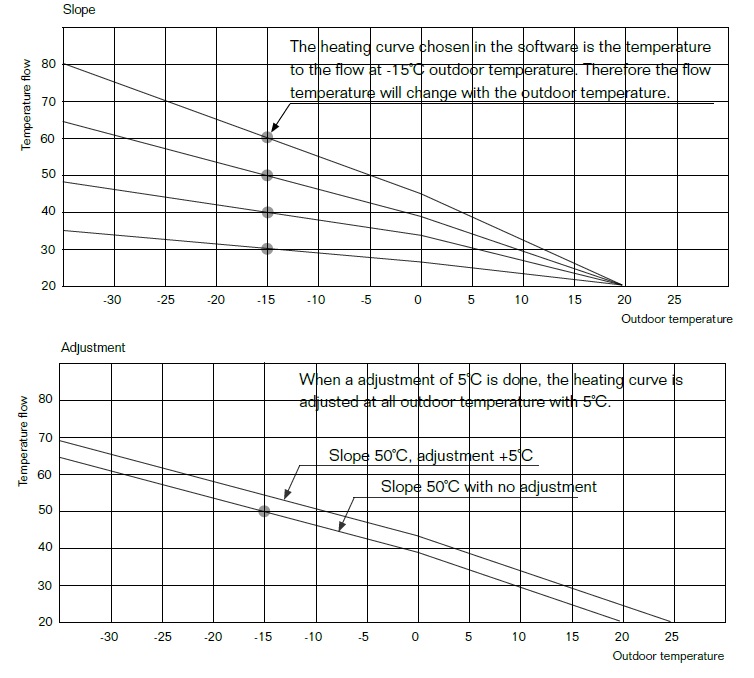Outdoor reset technology, which uses a single outdoor temperature sensor to determine boiler temperatures, is being eclipsed by innovative control technologies that utilize multiple factors plus artificial intelligence (AI) to increase efficiency.
As an efficiency solution, outdoor reset is a step above older technologies that didn’t use any external factors for setting the boiler temperature. However, with the most cutting edge technologies of today, there are many additional factors that can be taken into account, and which improve efficiency even more.
Outdoor Reset Technology
Outdoor reset is a technology that correlates boiler settings with the outdoor temperature in one spot outside the building. The purpose of this match-up is to increase efficiency by lowering systemic losses of energy that naturally occur from the production and distribution of thermal energy.
Here’s how outdoor reset works. Heating curves are shown in the image below. One of the curves is chosen manually by an installer or commissioning agent. The colder the outside temperature, the hotter the water that’s produced (or the longer the system runs, in the case of steam systems). The heating curve slope is chosen manually (top image) and the level of the slope is also chosen (2nd image).

Choosing an Outdoor Reset Curve
Often there are more than a dozen curves to choose from. There is inherently some uncertainty in choosing a curve. One could argue that choosing a curve is part art and part science. The main objective is to find a curve that will work for the building, and that leaves some room for error. Finding that a curve is not steep enough, for example, is only going to be discovered when it’s really cold out. This is not a good result. Yet by choosing a curve that’s steeper than necessary, some system efficiency is sacrificed.
Once the system is set up, the chosen curve is usually not changed more than once or twice, if at all, so there’s not much in the way of “fine-tuning”. Curve adjustments are only made after the fact, based on tenant complaints. If the curve is too steep, tenants will not complain, yet efficiency is sacrificed.
[Note that steam systems use outdoor reset, but don’t work exactly like this. Read about steam systems here:
A Modern Innovation for Improving the Efficiency of Steam Heating Systems]
Upgrading from Outdoor Reset to Leanheat AI
Among the factors that can be used to improve system efficiency is a group of building-specific factors such as how a building reacts to sun (e.g. amount of sunshine, time of day and time-of-year), wind (speed and direction), and “thermal inertia”, how a building responds to the heating system. Other important factors that are accounted for are individual unit temperatures, particularly those units farthest from the heat source. What’s needed to account for all these factors is energy intelligence software using algorithms that learn and adapt.
Leanheat AI actually takes into account all these extra factors using local weather forecasts, plus in-unit temperatures and humidity levels that are gathered by strategically placed sensors through cellular IoT technology. Without human intervention, a dynamic heating curve unique to the building is created. Boiler temperatures are controlled better, so there’s none of the typical large buffer that’s always been a necessary part of outdoor reset-controlled systems. As a result, the heating system runs more efficiently. In Finland, where Leanheat was first introduced, efficiency improvements of 10-20% have been realized.
An added benefit has been lower technical maintenance costs, such as from identifying and correcting housing units where climate control is problematic.
Back to top of post
Outdoor reset technology, which bases operational temperatures on the outdoor temperature, is going to be eclipsed by innovative control technologies that can utilize more factors. As an efficiency solution, outdoor reset is a step above older technologies that use no external factors for achieving a measure of system efficiency, but there are plenty of external factors that, if taken into account, would improve efficiency even more. Information about energy intelligence software that accounts for these factors follows below, but first a review of outdoor reset.
Outdoor reset is a technology that matches up heating and cooling temperatures with corresponding outdoor temperatures. The purpose of this match-up is to increase efficiency by lowering systemic losses of energy that naturally occur from the production and distribution of thermal energy.
Here’s how outdoor reset works. Heating curves are shown in the image below. One of the curves is chosen manually by an installer or commissioning agent. The colder the outside temperature, the hotter the water that’s produced (or the longer the system runs, in the case of steam systems). The heating curve slope is chosen manually (top image) and the level of the slope is also chosen (2nd image).

Choosing an Outdoor Reset Curve
Often there are more than a dozen curves to choose from. There is inherently some uncertainty in choosing a curve. One could argue that choosing a curve is part art and part science. The main objective is to find a curve that will work for the building, and that leaves some room for error. Finding that a curve is not steep enough, for example, is only going to be discovered when it’s really cold out. This is not a good result. Yet by choosing a steeper than necessary curve, some system efficiency is sacrificed.
Once the system is set up, the chosen curve is usually not changed more than once or twice, if at all, so there’s not much in the way of “fine-tuning”. There’s just too much uncertainty for any one person or team to deal with.
Upgrading from Outdoor Reset to Leanheat AI
Among the factors that can be used to improve system efficiency is a group of building-specific factors such as how a building reacts to sun (e.g. amount of sunshine, time of day and time-of-year), wind (speed and direction), and thermal inertia. Other important factors that are accounted for are individual unit temperatures, particularly those units farthest from the heat source. What’s needed to account for all these factors is energy intelligence software using algorithms that learn and adapt.
Leanheat AI actually takes into account all these extra factors and creates, without human intervention, a heating curve unique to the building. As a result, the heating system runs more efficiently. In Finland, where Leanheat was first introduced, efficiency improvements of 10-20% have been realized.
An added benefit has been lower technical maintenance costs, such as from identifying and correcting housing units where climate control is problematic.
Back to top of post
It’s now possible to lower energy costs by applying bundled technologies that find and use each building’s “Unique Energy Fingerprint” (UEF).  Our partner Leanheat has created energy intelligence software that bundles artificial intelligence (AI) with the Internet of Things (IoT) to determine each building’s UEF. The technologies integrate seamlessly with existing building assets. Building energy use is reduced through improvements in system efficiency.
Our partner Leanheat has created energy intelligence software that bundles artificial intelligence (AI) with the Internet of Things (IoT) to determine each building’s UEF. The technologies integrate seamlessly with existing building assets. Building energy use is reduced through improvements in system efficiency.
Before this technology became available, this level of efficiency improvement was not achievable in a cost-effective way using current assets. Improvements that have been made have been limited by the available technology. The potential for improved control technology has expanded greatly. Leanheat has been able to focus on realizing that potential for the purpose of lowering building energy use and costs.
There are two major differences between using a building’s UEF and today’s common control optimizer, outdoor reset (OR). First is that the UEF is based on more variables (as opposed to just one or two with OR), giving a more precise picture of the heating and cooling load at any given time. Second, the technology that determines the UEF is able to anticipate loads, and thus to proactively optimize settings so that energy use is reduced.
Proactive beats reactive.
Outdoor reset is reactive. It operates on a curve tied to the outdoor temperature. Outdoor reset depends on finding a heating curve that matches up with the output with the load. Because outdoor reset is reactive, there’s an inherent uncertainty with the load matching. To compensate, outdoor reset curves must provide some extra buffer, and that extra buffer creates inefficiency.
On the other hand, Leanheat proactively anticipates the heating and cooling needs of the building. It does this in two ways. First, it factors in more data related to weather and climate. Factors include:
1. Present and anticipated outdoor temperatures
2. Present and anticipated solar irradiation (sunshine) on the building
3. Sun angle (latitude, time-of-day, and time-of year)
4. Wind direction and speed (“building wind chill”)
Other factors are indirectly (and automatically) factored in based on how the building responds:
1. Capacity of the heating and cooling system assets
2. Building mass & orientation
3. Insulation, windows, etc.
4. Air infiltration
Together, these are the variables that make a building’s UEF. Because it uses more variables, it’s able to get a more complete picture of the building’s energy load.
The second way that the Leanheat technology is proactive is that it monitors how building data correlates with naturally occurring changes in weather. As a result, the technology finds the UEF and its algorithms keep the building systems matched appropriately to current and incoming weather. The result is a typical cost savings of 10-15%.
Proactive heating and cooling control is especially important in buildings that react slowly to changes in weather and climate factors. Of course, any building with traditional controls can react slowly to a cold front with wind and rain or snow. Or when the cloud cover breaks up and suddenly the building is in full sunshine. Proactive technology controls the water temperature (or steam) with greater precision (and “less cushion”) than is possible with a reactive-based system like outdoor reset.
Back to top of post



 Our partner Leanheat has created energy intelligence software that bundles artificial intelligence (AI) with the Internet of Things (IoT) to determine each building’s UEF. The technologies integrate seamlessly with existing building assets. Building energy use is reduced through improvements in system efficiency.
Our partner Leanheat has created energy intelligence software that bundles artificial intelligence (AI) with the Internet of Things (IoT) to determine each building’s UEF. The technologies integrate seamlessly with existing building assets. Building energy use is reduced through improvements in system efficiency.